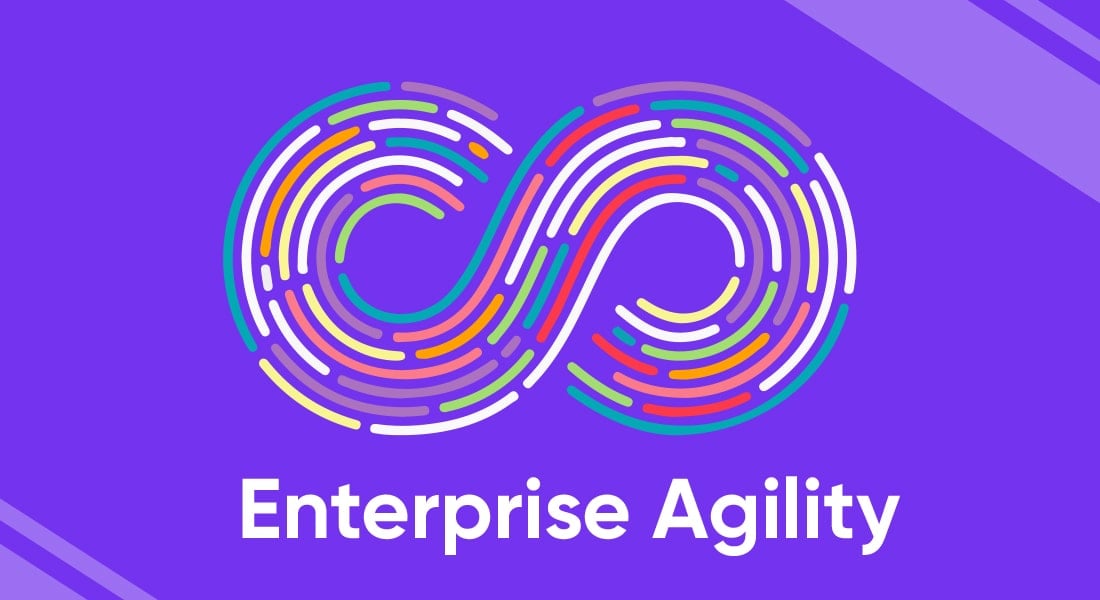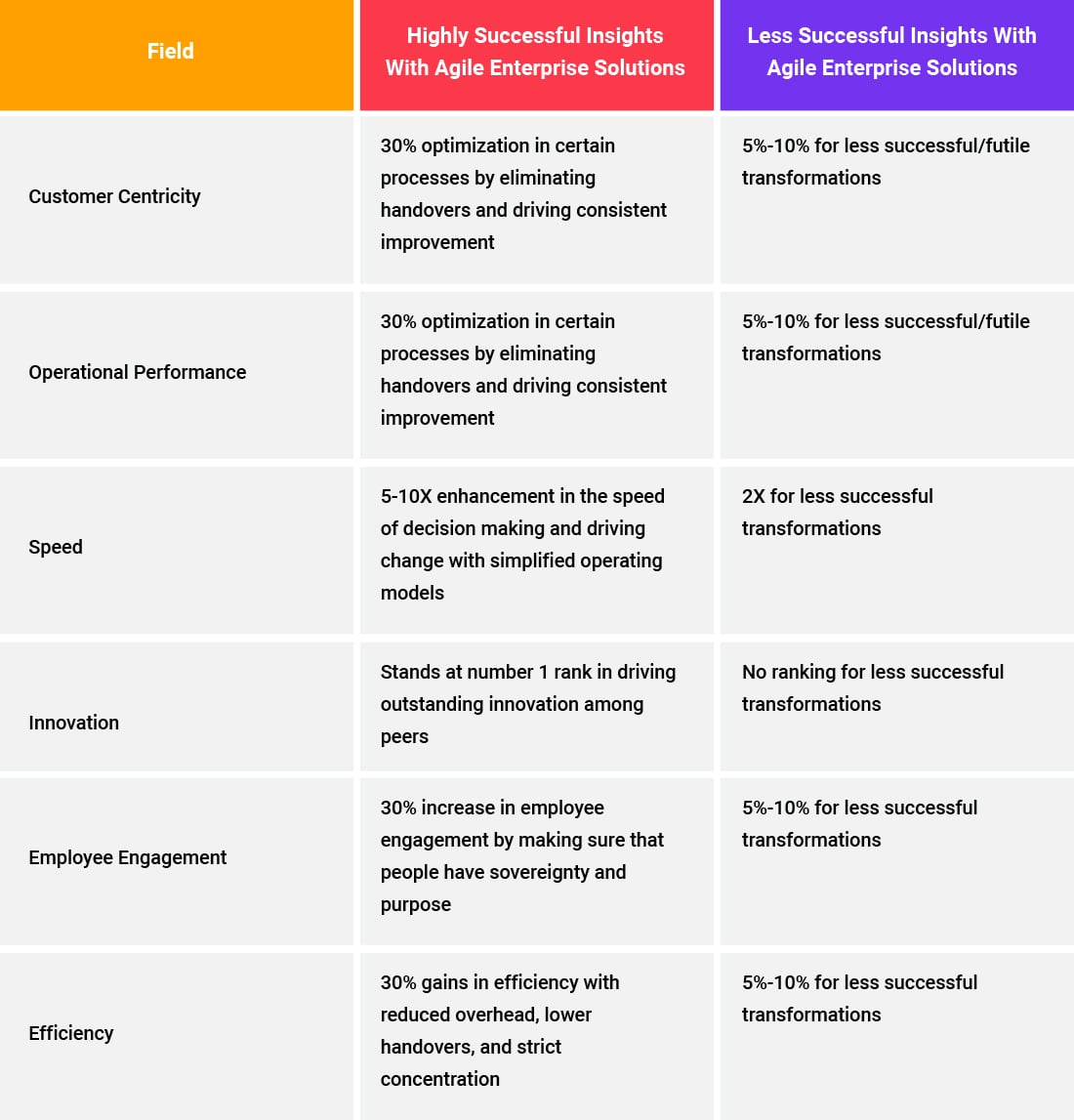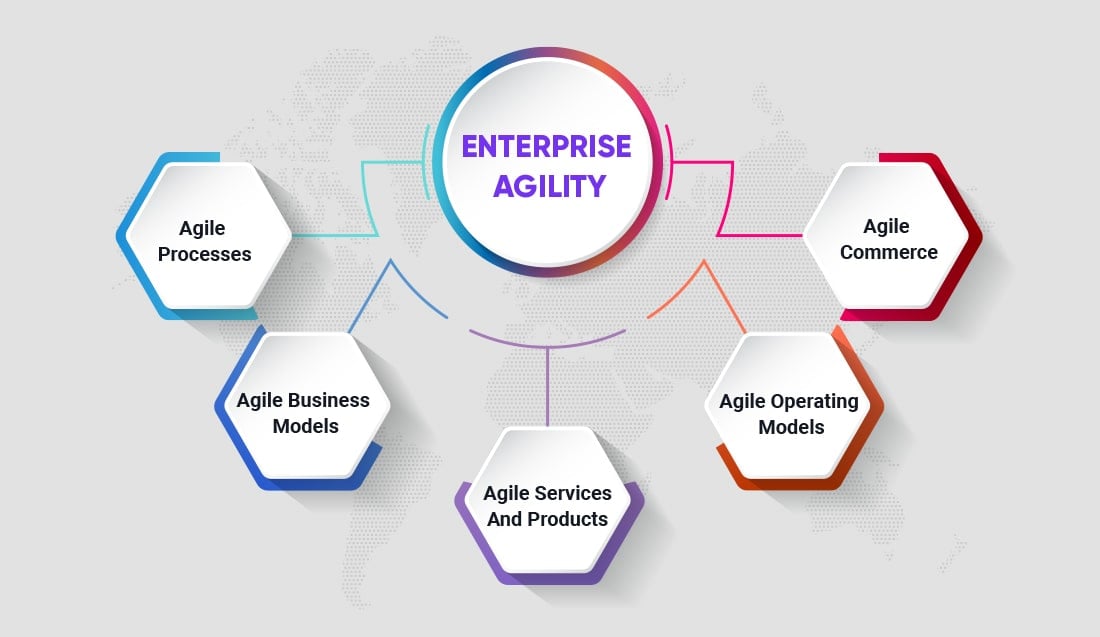Quick Summary:
Enterprise agility is expanding considering the rapid changes by digital disruption, new regulations, and climate changes. Technically, it is gaining wider recognition and reaching more audiences. However, what exactly is the concept of Agility in business? Well, read on.
Table of Contents
What is Enterprise Agility?
Enterprise agility is a model to scale agile methodologies beyond the development teams. With a robust and efficient agile transformation, enterprises can lower operating costs, enhance customer satisfaction, and render employees engagement.
Organizations that have sensed and attained success in development are better positioned to expand these practices across the firm to enhance the impact of agility across wider aspects of the business.

Enterprise agility transformation involves more processes than traditional ones. Enterprise agility initiatives are spread across wider teams compared to the traditional agile approaches that solely concentrate on IT-centric roles.
Ideally, a traditional agile team consists of testers, developers, operating teams, DevOps, etc. With time, the team involves security teams, data engineers, business matter experts, and data scientists. However, the case is different with enterprise agile methodology. It is the intrinsic extension or chief agile concept across diverse teams including legal, marketing, HR, finance, and distinct engineering disciplines.
Are you a startup enthusiast yearning to build innovative digital products that can solve today’s business challenges?
You need battle-tested Agile Development Services to score high on your Enterprise Agility. Get in touch with the Best Agile Software Development Company and attain the extraordinary.
Enterprise Agility Transformation- Essential Insights
When enterprises adopt agility in business, they sense highly successful enterprise agility transformation. This leads to a step-change in performance. However, the impact is obtained in diverse dimensions. Below are a few essential insights of business agility examples and benefits of adopting enterprise agility.

All in all, Around 65% share of firms report a remarkable impact on their financial state and performance after enterprise agile transformation. Considering all these statistics, it is imperative to state that the benefit of enhancing enterprise agility is mind-blowing.
How to Achieve Enterprise Agility?
Enterprise agility is not obtained by cloud-first approaches and workforce strategies but through a well-grounded holistic approach. Below is a list of 5 points that denotes how to obtain robust enterprise agility.

Agile Processes
Processes become Agile processes when software-mined/defined. Techniques like process mining helps to enhance process optimization and monitoring. In addition, it assists firms in analyzing the ongoing operations besides suggesting the possible shifts available. Key Process Performance Indicators (KPIs) indicate where you can improve the processes and enhance them.
Agile Business Models
The platform business models are naturally agile when it comes to KPIs for product development. This is because they allow swift growth and amendments to the ecosystem by depending on external consumers and producers to render original physical/digital products, social currency, and services. For example, Apple does not require strenuous lifting while operating the app store. New application providers add their applications easily following a consistent cycle of growth. In other words, more apps denote more buyers. With this permissionless revolution, frictions are reduced. As a result, participants innovate more into the platform that expands the platform’s value proposition.
Agile Services And Products
Digital services are naturally agile. They can scale up and down and be deployed, designed, handled, and maintained based on demand. The crucial elements are approaches like cloud and DevOps. However, you can explore a wider range of intriguing techniques to implement flexibility and resilience. Say, for instance, NetFlix is popular for chaos engineering (testing).
This indicates that developers constantly work in an unreliable environment with unexpected services and outages. Physical products are automatically agile when they own elements like modular design. For example, modular phones, autonomous vehicles, data centers, etc.
Agile Operating Models
Similar to all the other models, operating models are agile naturally. These models identify and answer the external stimuli, thereby swiftly reconfiguring operating processes.
Agile Commerce
Your transactions become agile when you set the price, customize, and sell your offerings based on AI. It acts as the embedded intelligence to assist in making commerce offers and decisions with dynamic and customized price calculations. From the customer angle, you attain agility from smart virtual bots to (manual) customer service agents. It facilitates improvised sales conversion rates and smart contracts that bring in more possibilities for intelligent commerce.
Viewing these 5 points will help you get a clear picture of Agile enterprises and the advantages of building natural adaptability and agility in your firm.
6 Ways How Can Businesses Bring Change Through Enterprise Agility
To bring rapid changes, enterprises need to adopt an agile enterprise solution that is ideally designed for the requirements of the Enterprise. That said, below is a brief list of 6 Ways that state how enterprises can introduce changes in their present.
1. Agile Should be Your Mindset
When we mention Agile, we indicate smooth communication, collaboration, transparency, and offering business value over strict deadlines. In other words, the objective here is to eliminate traditional practices and adopt new and unique approaches in terms of working.
2. Adopt Hybrid/Agile Frameworks Involving DevOps Practices
It is usual to adopt a Step-by-step gradual approach towards Agile by mixing waterfall methodologies and Agile. If you wish to move faster, it is better to apply Agile/lean principles from strategic planning by working in Agile dev teams.
3. Change Teams to Cross-Functional
Here, making teams cross-functional is all about merging business, development, testing, and delivery teams on an engaging platform with associated activities and workflows that deal with the same objective. However, one thing that is essential here is excellent collaboration and communication.
4. Incorporate Agile Top-Down and Bottom-Up
Because agile is all about a mindset change, agile must get incorporated across all the tiers of the firm. Nonetheless, implementing this facet means that your teams move speedily and diversely from the product owner to the IT teams. Alongside, teams must give continuous feedback quite often. Not to forget, it should be a transparent environment.
5. Shift Left: For Consistent Testing
Earlier, these quality assurance activities were quite complicated. It required an extra skillset and team reorgs. However, you cannot achieve Agile and DevOps without a left-shift approach. It helps you identify risks to get a wider scope and fine quality right from the beginning of the cycle.
6. Incorporate Agile into Metrics and Budget
Considering the crucial aspects of the organization, when it comes to modifications in finance and budget matters, it is ideal to begin small. Incorporate Agile gradually by making the budgets even more transparent. You may even lower the bureaucracies for a faster approval flow.
Conclusion
Currently, traditional approaches in the organization have been showing shortcomings for quite a time now. However, if businesses want to improve their quality, productivity, and resource utilization, they should not think twice before adopting an Agile mindset.
This is because agile organizations such as Bacancy, continuously enhance their processes to render the desired outcomes. By using insights from every agile iteration, teams can upgrade their work approach to raise productivity. When businesses embrace agile principles across the company, it helps them maintain excellent productivity in work and operations right after their initial switch to agile forms of working.
Your Success Is Guaranteed !
We accelerate the release of digital product and guaranteed their success
We Use Slack, Jira & GitHub for Accurate Deployment and Effective Communication.




